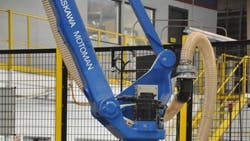One Robot Brings Efficiency to Three Production Lines
Two robotic arms can accomplish a lot in a short time on a production line. At Kelly-Moore’s paint plant in San Carlos, Calif., one of the most impressive accomplishments was how fast they returned a major chunk of their investment—76% their first year. They’re palletizing cans of paint from four production lines (two lines each), resulting in lower production changeover times and fewer injuries among workers.
Intelligrated’s Alvey robotic palletizing system uses robotic arms sourced from Motoman. Intelligrated customized this set-up with end-of-arm tooling and system controls. The tooling handles unwrapped trays of quart or gallon paint cans, picking up configurations of 2x2 gallon and 3x3 quart paint can patterns. With the help of a vacuum arm this system can also handle the loose cardboard trays.
Working with Tepro Machine & Pac System and its line of Unigripper lifting tools, the final design lifts the cans and secures the tray with a separate pivoting vacuum arm that descends as product is moved to the pallet.
The resulting labor savings enabled this Kelly-Moore plant to eliminate almost all overtime while decreasing lost-time accidents from 23 in 2005 to five in 2009. Line changeovers went from 45 minutes to nine minutes.
With this success in San Carlos, it was a no-brainer for the company to consider doing the same at its Hurst, Texas, plant. However, this would not be a paint-by-numbers repeat performance. In fact the Texas facility would put state-of-the-art robotic palletization to a more rigorous test. It would employ one robotic arm to handle the output of three lines.
The first challenge for this new implementation was the plant production environment itself. There are seven buildings on site with continuous flow from receiving of raw materials, through manufacturing, to packaging, to storage and finally, distribution. This facility got to be the age and size it did through year-by-year piecemeal additions. Forty-five years ago the site started with two buildings.
“We haven’t had a good flow of manufacturing,” admits Calvin Chun, manager of this Kelly-Moore plant. “Our plan is to improve our flow from the mixing and packaging sides.”
That may entail taking apart and redesigning operations to get a better flow of manufacturing. Instead of taking down the buildings, however, the plan is to remove internal walls.
This leads to one of the key benefits of the palletizing robot Kelly-Moore installed in this environment. The robotic lines were laid out to give the company the flexibility it needed to move them and reinstall them elsewhere. That could also entail the addition of more floor conveyors and sensors to enable material movement from where it’s packaged to where it’s stored. The thinking is, with a straighter flow from production to warehousing, the company might be able to eliminate some lift trucks.
This space utilization strategy started five years ago when Chun and his team were trying to improve their palletizing efficiencies. At the time everything was done manually. It took three or four workers an eight-hour shift—sometimes 15—to stack paint products and packaging materials. From the labor side alone, that was very expensive. Automation seemed like the best solution.
Two years prior to that, the company had already purchased standard palletizing equipment for one production line. But Chun wanted more versatility in the packaging areas. He knew that the company’s sister location in San Carlos installed two robotic units that helped them reduce labor and improved efficiency, so the goal was to capitalize on that success.
Besides the poor work flow, the Texas operations included much heavy lifting and downtime due to the need to retrieve a variety of materials from several lines and move them around. Chun believed that alone would contribute mightily to a payback from an investment in robotics.
Chun’s team worked with Intelligrated to create an end effector that would be able to handle five-gallon pails, four-gallon containers on a tray or in a corrugated box, and also a pallet, and discriminate between them based on weight. Those represent four functions beyond this robot’s original design spec.
The robot services two lines handling 5-gallon pails as well as one handling 1-gallon cases. It does this all at one time. The San Carlos facility’s robots use individual, product-specific end effectors. Because of the Texas site’s need for flexibility, Chun’s team was determined to combine three lines to handle fives and ones as well as palletization.
“We have eight production lines and this robot project manages three of them,” Chun notes. “In the next five years we’ll replace some of the older palletizers we installed seven years ago with the robotic units.”
This site is in the beginning stages of automated material handling. The next step is to go to a warehouse management system (WMS). Right now the site is handling orders but there’s nothing to control materials picking, and a WMS will help there.
Until then, this robot is reducing the wasted motion of manual labor and cutting packaging time. Chun started the project anticipating a two and a half year ROI, but the wait for payback has been reduced to a year and a half at the most. The labor savings did not result in layoffs. Employees were retrained for mixing operations.
“A lot of the people at the front of the line packing have adapted to this system quickly,” Chun says. “These materials go directly to our Kelly-Moore stores where they’re unpacked. The tight consistency of the way the material is packaged enables our warehouse to move material easier. The robotics may have been a little more expensive, but we now have more versatility and the ability to take on additional lines.”
About the Author
Tom Andel
Editor-in-Chief
Tom Andel is an award-winning editorial content creator and manager with more than 35 years of industry experience. His writing spans several industrial disciplines, including power transmission, industrial controls, material handling & logistics, and supply chain management.
